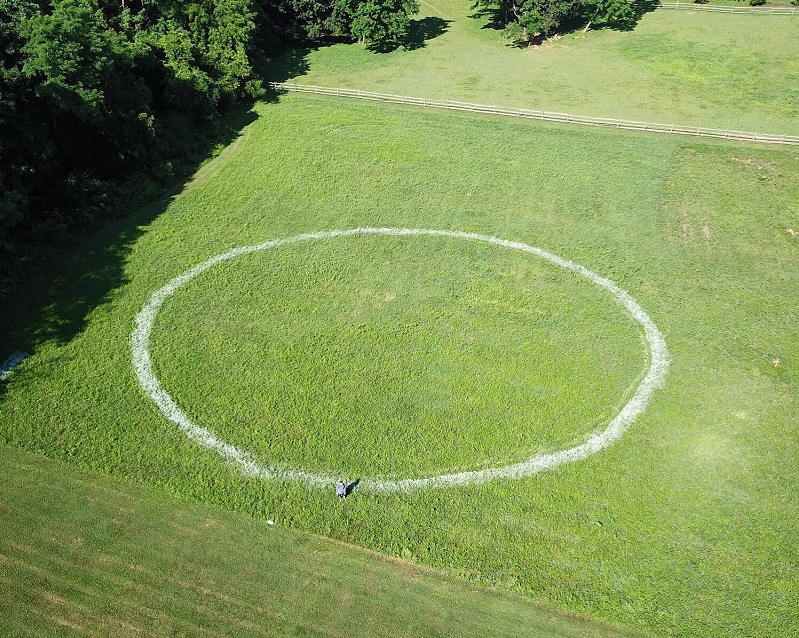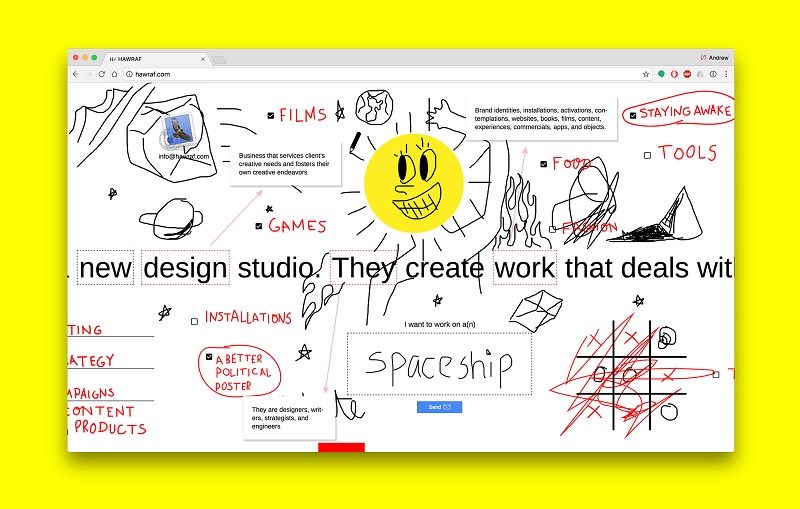A partner at HAWRAF, a studio using design to apply new ideas, technologies, and methodologies to their work with clients and self-initiated projects, Andrew Herzog worked at the Google Creative Lab where he designed AI-assistive drawing tools and a wall installation made-up of 5,880 arcade buttons. His personal practice involves using tools, materials, and actions that are commonplace as a way to probe art making. He is a professor of Interaction at the School of Visual Arts and The New School. His work has been featured at the Cannes International Festival for Creativity, the Art Directors’ Club, and in 2017 he was named in PRINT Magazine’s “New Visual Artists: 15 under 30” list. BR had the pleasure of conducting an exclusive interview prior to his arrival in Romania to be a speaker at Unfinished Festival. You can find the results of our great conversation below.
By Romanita Oprea
What drives you every day?
I’m naturally just a very curious person. I’m a listener. I like to hear what people have to say. I think what keeps me motivated and drives me to continue pursuing ideas and making things is simply curiosity. Learning is another driving force for me. Whenever possible, I want to be learning something new. Whether that learning is gleaned from a book, from someone I’m talking to or from something I’m experimenting with. For the installation I am doing at UNFINISHED – Circle or curve? I am creating a kilometer in circumference circle painted around the National Museum of Art of Romania. I had to learn and experiment quite a bit for this project. I had to figure out how to paint it? What mechanism would I use to paint? How would I walk and paint at the same time? How can I make a paint that isn’t destructive or permanent? How big will the circle be? How much paint will that take?

I’m also interested in the relationship between the artist and the viewer and where they intersect. Circle or curve? is an exploration of the viewer’s and artist’s shared responsibilities and roles in an artwork. Neither the artist nor viewer can see the entire circle from the ground. To complete the artwork, both the artist and the viewer must rely on their ability to envision the whole circle from the point where they stand. The artist walks and draws by assessing the previous, current and future path, visualizing the circle in curves before viewing it whole, photographed from above. Just as the artist envisioned the work partially while creating it, the viewer must also assume the responsibility of seeing the circle in parts while walking it. Comprehension of the work relies on continual assessment of their path as they walk the drawing. The viewer re-enacts the process of the artist to view the whole work – conferring to the viewer the responsibilities of the artist.

What are your failures and how have you surpass them?
I suppose I fail a lot. I’m not a fan of the “Fail often, Fail more” mantras, but I try to be open to the possibility of failure knowing that when I fail there’s an opportunity to learn. Learning is, as I’ve said, a big part of my process. Failures are just part of experimentation which ideally leads to learning. Obviously, failure is not always an option, which is why I don’t agree with the “Fail all the time” mantras. When I can, I find it useful to build in time for experimentation and allowing the first time that I do something to be a learning experience. I know typically the second time I do it will be better and the third better yet. And by the fourth time I’m bored of it. Plus, it’s likely that what I’ll learn from those experiments I’ll be able to apply to something else that is totally unrelated. In preparation for the Circle or curve? installation I had a lot of failed experiments, but I expected that. All of those failures led to learnings that eventually made the project possible.
What has the Google Creative Lab represented in your career path? What are the main things you learned there which helped you later on?
I learned a lot from working in the Creative Lab. Perhaps, most importantly I met my 3 partners that I co-founded HAWRAF with. The other thing that was interesting about working for Google was that you are making things that will likely be seen and used by millions of people so you have really consider it’s accessibility.
You and the HAWRAF team stayed up for 26 hours straight to complete 26 creative projects of an hour each, live-streaming every second of it. How did that happen and what made you do it?
As a studio we are interested in transparency. A core practice of our studio has been trying to publish and talk about the process and things we learn. The A-Z project was the first of those type of projects. It involved exposing what is usually a monetized insight of a design studio – its process. We wanted to put ourselves in a situation where we had to repeat our process over and over again and allow people to watch and ideally learn from successes and failures. So we settled on the idea of making something every hour for every letter of the alphabet for 26 hours straight. We hacked together three live streaming solutions into one site where people could see what we’d produced each hour and watch us as we worked.
You stated that creative accessibility was a core pillar for you at HAWRAF. Can you further develop the idea for us?
The idea of creative accessibility is a lofty one. Perhaps too lofty for one small design studio. It came out of the realization that the design community is not one of transparency. It tends to exclude more than it includes. We felt like if we published our learnings and findings that if someone were to stumble upon them they would be one step ahead of where we were when we started. Ideally that would make it a little bit easier for people who hadn’t had all the opportunities we had to make a go of it.

How important is the interactivity between your work and people for you? Why?
In my work I find that interactivity has become a core tenant. It’s also a big part of the work we do at HAWRAF – we feel that anything can be interactive. I’m a good listener and I’m really interested in what people have to say. I think we’re also in an era where people are making things – they’re taking photos, making short videos for their instagram. Everyone, even my dad, has an instagram and so by nature of the platform they are curating images which I think raises the general consciousness of how things are made and media in general. Because of this I think people are more prepared to interact than ever before. In many instances they don’t just want to be talked to they want to talk back. And, talking back can take many forms, but I think overall people want to feel like they are accounted for in the things they see in the world. Afterall, we all inhabit the world and space for our opinions and thoughts should be represented in it. For this reason I think interaction has become an important part of my work.
You created Auto Draw. What was the main purpose and your target?
My dad worked at a label printing shop working on presses when I was a kid. There was a graphic artist there, Jess, responsible for setting up the files for the presses. As a kid, whenever I would go to the print shop with my dad I would inevitably end up hanging out with Jess. When it came time to decide on colleges I had no idea what I wanted to do, but the girl I was in love with, who later become my wife, was going to art school so I decided I would do the same. Because my dad knew Jess and Jess had a job, my parents were ok with me going to art school if I studied graphic design. Prior to getting to art school I never touched a digital design computer program and there I was surrounded by kids that had. It was an intimidating experience and one that I think would turn a lot of people away. Many years later, I was thinking about these experiences when I got to Google and how because the programs are so expensive it creates an economic barrier for entry into design. I felt like Google was positioned as a company that makes tools accessible – so it should make a tool that could help facilitate creatives, young and old, who are curious about design, but don’t have access to the tools. I hoped that it would provide an onramp for people who may have creative inclinations but weren’t able to chase it. At the time we were doing a lot of work with artificial intelligence and drawing as well. We ended up being able to merge that work into the tool so that even if you weren’t “good” at drawing Autodraw could help get you started by suggesting drawings from a bank of hundreds of drawings made by artists and illustrators. I don’t know if it achieved all of that, but I’d like to think that at some point if one person uses it and it gives them a sense of confidence and validates their interest in a creative pursuit than it’s done its job.
How do you think AI has changed the design and art in your lives? What will happen in the next two years from this standpoint?
I think AI will inevitably play a role in the future of design. We’ve already started to see the possibilities with style transfer experiments in animation and video. It’s only a matter of time before these tools will be helping us to fill out identity packages and pick an algorithmically perfect typeface. Ultimately AI is a tool. Just like computers. The bigger question is how to we keep these tools accessible? As we progress technically we have to understand that we are not all moving at the same pace. My fear is that with the advancement in tools the divide between those who have and use them and those who don’t will only become bigger leading to the potential of art and design being even more siloed and exclusionary.


:quality(80)/business-review.eu/wp-content/uploads/2018/09/aherzog-profile-01.jpg)

:quality(80)/business-review.eu/wp-content/uploads/2024/07/Ilustratie-2.jpg)



:quality(80)/business-review.eu/wp-content/uploads/2024/06/22C0420_006.jpg)

:quality(80)/business-review.eu/wp-content/uploads/2024/06/COVER-1-4.jpg)



:quality(50)/business-review.eu/wp-content/uploads/2023/08/U23_Anelise_Lakshmi.png)
:quality(80)/business-review.eu/wp-content/uploads/2024/06/br-june-2.jpg)
:quality(50)/business-review.eu/wp-content/uploads/2024/07/VGP-Park-Timisoara_-8thbuilding_iulie-24.jpg)
:quality(50)/business-review.eu/wp-content/uploads/2024/07/America-House-Offices-Bucharest-Fortim-Trusted-Advisors.jpg)
:quality(50)/business-review.eu/wp-content/uploads/2024/07/BeFunky-collage-33-scaled.jpg)